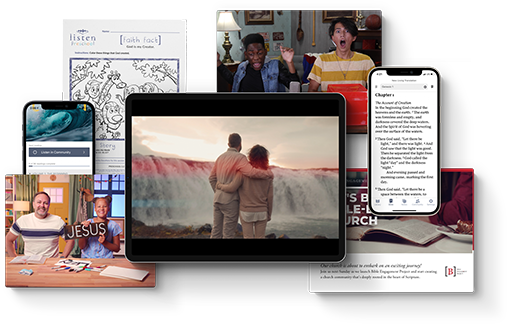This is That: How Jesus Leads Us To Think Out Scripture
By Chase Replogle | Posted In Studying the Bible
On the Day of Pentecost as Peter stepped forward to address the crowd, it was the prophet Joel that first came to his mind. He explained that “this is that” (Acts 2:16, KJV) which the prophet Joel had spoken of. Peter did what was characteristic of his culture and the writers of the Bible. He drew from the deep well of Scripture which permeated his heart and mind. Force Peter to speak without preparation, and you’re likely to hear Scripture. Give him time to formulate his thoughts, and you’re likely to hear more Scripture.
One of my favorite professors, Dr. Wave Nunnally, often quotes one of his own teachers in describing the world of the Bible as a Scripture-bound society. Their world was formed and encapsulated in the sacred words and stories they had inherited. They thought and lived in the language of Scripture. It’s how they perceived the world and the events around them.
Most of them would have had large portions of Scripture memorized and would have understood whole passage of Scripture with little more than a phrase or word of prompting.
If I said to you, “Once upon a time,” or “Somewhere over a rainbow,” or “I am your father,” or “Amber waves of grain,” I’m pretty sure you would know exactly the story, movie, or song I’m alluding to. They are a part of our American culture, our language, and our way of expressing things. Think a moment longer, and those words can evoke emotions and feelings and certain nostalgia. The Scriptures were like that for many of the men and women of Jesus’s day.
The Bible anticipates a rich knowledge of Scripture to grasp Scripture fully. It anticipates a certain level of biblical knowledge and engagement to fully understand what is taking place.
As I’ve been preaching through John’s Gospel, I continue to be struck by how soaked in Scripture John’s words and images are. You can probably think of a few; many are obvious and well-known. Consider Jesus’ use of the Old Testament title, “I am.” John included several of these uses as key features of his story’s structure. There are also the familiar images of Jesus providing bread to the multitudes like the manna in the wilderness or riding into Jerusalem on the foal of a donkey. But these allusions, images, and quotations don’t just drop out of the sky; they indicate how deeply John and Jesus were immersed in Scripture.
I want to offer you one of my favorite examples from John’s Gospel. It’s a good example of how deeply Scripture informs Scripture. I won’t do all the work for you; I’ll leave some of the digging for you to do on your own. Hopefully, you’ll discover the joy of it for yourself.
Jesus Forced Them to Interpret
One of the first healings in John’s Gospel was a lame man Jesus found at the pool of Bethesda. It’s told in John chapter 5. Unlike the official’s son healed in the previous chapter, Jesus found this lame man completely on his own, with no initiating appeal for healing coming from the man.
John went into great detail to set the scene in which Jesus healed this man, giving us more details than many other healing scenes. John specifically located that man at the pool of Bethesda outside of the Sheep Gate. Being surrounded by several shaded colonnades, the pool had become a gathering place for the sick and broken as they waited and hoped to be healed by the pool’s water.
What’s unique is that Jesus saw a particular lame man in the midst of the crowd and approached him to initiate the conversation that led to the man’s healing. What was it that drew Jesus to that particular man? There is nothing remarkable about the man’s faith. He failed to recognize Jesus, and when confronted by the Jewish leaders, he was quick to put the blame on the person who healed him.
Jesus’ words are also direct and intentional. He did not just tell the man to be healed or just to walk, but “Jesus told him, ‘Stand up, pick up your mat, and walk!’ ” Of course, the thing that makes this story so significant is that the man’s healing took place on the Sabbath. It took place publicly on the Sabbath which immediately unleashed anger and accusations from the religious leaders.
But as they began their interrogation of the healed man, Jesus was no longer there to be questioned. He had healed the man and slipped away before anyone could recognize Him or ask who He was. Even the man healed would not know who had healed him until Jesus later approached him worshipping in the temple.
Now assuming, like previous generations of believers, that you have most of the Old Testament memorized, does it seem like John and Jesus are setting this story into the context of another?
I often ask my congregation questions like that. They chuckle. I, nor they, do not have so much Scripture memorized. And to be fair, the religious leaders didn’t seem to make any connection either. Perhaps this question of putting together the pieces to understand the intentions of Jesus is part of the actual point. We, like those who that day witnessed it personally, are left trying to make sense of it. Why is Jesus so specific: that specific man, that specific place, that specific day (after all, he had been laying there every day for nearly forty years), and that specific command?
At the center of the conflict was the Jewish leaders’ concern, not necessarily with the healing—the Law allowed for certain life-saving acts on the Sabbath—but with picking up that mat. Or as John recorded them scolding, “You can’t work on the Sabbath! The law doesn’t allow you to carry that sleeping mat!”
They were most likely thinking of a passage from Jeremiah, in which the prophet confronted Israel over their lax approach to Sabbath sacredness. God instructed Jeremiah to go stand at each of Jerusalem’s gates and tell the people to stop carrying any load on the Sabbath. Jesus actually used the same Greek verb, which means “to take up,” as the Greek version of that word used in the Jeremiah passage. To the religious leaders, it may have sounded like Jesus had intentionally instructing this man to violate Jeremiah 17. To them, it was pretty open and shut.
With its allusions to Jeremiah standing in the gates and John ensuring we know that this pool is at one of those gates, it’s hard not to sense the whole scene of Jeremiah here in the intentional act of Jesus. But Jeremiah 17 is more than just a warning; it comes with a promise. Jeremiah went on to explain:
“But if you obey me, says the Lord, and do not carry on your trade at the gates or work on the Sabbath day, and if you keep it holy, then kings and their officials will go in and out of these gates forever. There will always be a descendant of David sitting on the throne here in Jerusalem. Kings and their officials will always ride in and out among the people of Judah in chariots and on horses, and this city will remain forever. And from all around Jerusalem, from the towns of Judah and Benjamin, from the western foothills and the hill country and the Negev, the people will come with their burnt offerings and sacrifices. They will bring their grain offerings, frankincense, and thanksgiving offerings to the Lord’s Temple.”
Jeremiah 17 sets the rules of Sabbath into a future hope, a promise, an expectation of something better to come: an eternal throne, kings riding through those same gates, and worship pouring into the temple. Is it any surprise that Jesus later found the healed man worshipping in the temple? Is he perhaps the first of this coming flood of worship?
The leaders immediately saw Jesus as a violator of the Sabbath, but I think a full reading of Jeremiah anticipates another possibility, Jesus might be the one who came to fulfill the Sabbath’s promises. He might be the one to whom the Sabbath was pointing. He might be that king riding through the gate to establish an eternal throne and an eternal place of worship.
Looking beyond Surface Things
But Jesus quickly withdrew from the whole scene. He didn’t explain any of His actions or words. It’s as if He left them with these allusions and watches to see how they would interpret what they had seen and received. He left the questions hanging.
Who is He? What is the Sabbath? What does Jeremiah really say? Might Jesus be something more? Could He be Lord of the Sabbath?
This miracle came at a time when Jesus was constantly pursued by crowds who gathered to see His miracles and signs. They pressed Him constantly for more. But as is so often true with Jesus’ words and actions, it’s not just the surface observations that really matter; it’s also the things they point to. What He did is often like what He spoke—a parable. His words and actions reveal those who are willing to search, those who are willing to dig.
They would be forced to interpret Him by their own reading of Scripture, and so are we. Unfortunately, too many Christians settle for what’s on the surface. They come to see the sign and never fully discover to what it points. Jesus, by His words and actions, compels us to engage more deeply, search with great fervor, ask more pressing questions, and study more deeply the full testament of Scripture.
Keep asking. Keep seeking. Keep knocking. There is more Christ has to offer. There is more for you to find.


